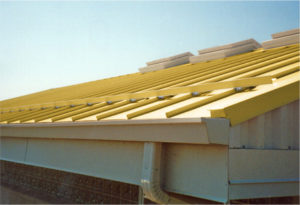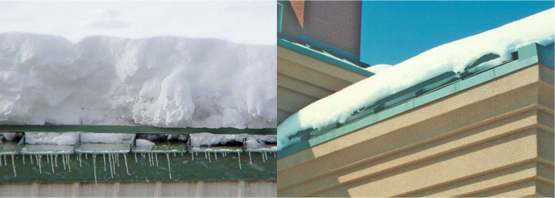
ColorGard—for a perfect color—match that lasts the life of the roof! None of our competitors dare to stand behind the performance of their own products this way.
The sudden and unexpected release of snow from the roof can be dramatic, posing a serious threat to property and passers-by. ColorGard dramatically reduces the risks associated with rooftop avalanches and maintains the clean colorful appearance of the roof with perfect color and finish matching, which lasts as long as the roof itself! ColorGard is the only snow retention system designed and engineered on a site-specific basis; guaranteed to perform, to not damage the roof or finish, and to exactly match the roof color—for the entire life of the roof.
Today’s premium Kynar 500® and Hylar 5000® (PVDF) paint systems used on metal panels are “coil-coated” and oven-cured. This is the only finish application method that can be warranted against color fade for 30 years or longer. Nothing can equal it! So, why settle for less in a snow guard system? While some dyes, powder-coats and air-dried color application methods may initially simulate a perfect match, the color soon begins to fade and becomes increasingly mismatched with a few years of age. By utilizing a strip of the actual roof material, ColorGard perfectly matches the roof—forever!
ColorGard is mechanically attached with S-5!® clamps. S-5! is the trusted name in metal rooftop attachment technology worldwide. S-5!’s , round-point setscrews grip the seam securely without penetration and without damage to the panel’s protective finishes. The clamps are precision-machined from aircraft quality, high tensile aluminum—not cast or plastic. All related hardware is non-ferrous stainless steel for lasting performance

When the blanket of snow on the roof is dense and wet (not solidified), it may tend to undergo compression buckling, pushing a “loop” upward from the roof surface as the heavy mass compresses toward the eave where restrained by snow guards. This loop, can fold over the blanket and the snow retention device(s) in the downslope direction, often breaking and in many cases falls from the roof.
Compression buckling tends to happen more when blankets are thin. When the thickness of the blanket increases, it gains compressive strength. This tendency is related to both the vector force (and mass) and the compressive strength of the snow. Hence the following variables are at play:
Slope: Buckling is more common with steeper slopes as vector forces increase
Thickness of snow blanket: Thicker blankets generally have greater compressive strength and lower mass, and are therefore less likely to buckle
Moisture: Greater moisture content increases mass, which in turn increases the likelihood of buckling
Temperature: Warmer temperatures decrease compressive strength, and this increases the probability of buckling
Length of snow blanket: Longer blankets have an increased vector and a correspondingly increased probability of buckling Contrary to popular myths, the height of the snow retention device plays no role in the probability of a snow blanket to buckle, and heavier accumulations decrease probability, not increase it.

Surprisingly, a thin blanket of snow poses a greater risk of buckling than do thicker blankets. Commentary – Solution This is analogous to compression buckling of a steel column, except that the properties of the snow are less predictable. The problem is noted when the snow blanket is minimal in thickness and very wet (lacking in body and compressive strength). Two things decrease the likelihood of the snow buckling:
- reducing the unsupported length of the column (snow blanket) by adding rows of snow retention
- increasing the sectional size of the column (snow blanket), i.e., increasing the snow depth, which is impossible to control. When the snow blanket increases in depth, it is less likely to buckle.
Our experience has shown us that the most effective approach for adding rows of snow retention is to add a second row some 8-10’ more or less above the first. If the blanket buckles above the upper row, the “loop” is usually still contained above the lower row.